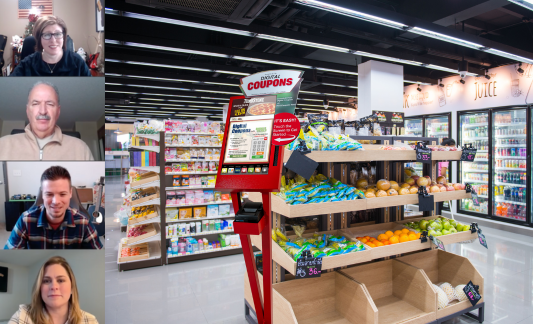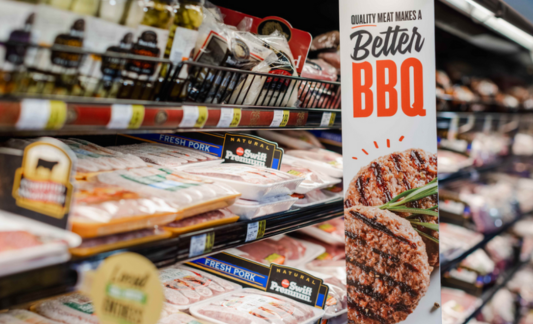Help Isom IGA recover from devasting floods

5 min read
How Grocers Can Use Data to Personalize Shopper Experiences
Written by IGA News
May 29, 2024
One of the big promises of Artificial Intelligence (AI) and Big Data analytics is the ability to use shopper purchase data to create innovative and personalized customer journeys.
In grocery, an optimal personalized customer journey means much of the marketing and advertising the shopper sees is based on their actual needs and desires, including the ads outside of the store, the deals they receive, and even their in-store experience.
While this type of personalized customer journey requires technology to process massive amounts of data, the concept of a personalized shopper experience is nothing new.
“Personalized shopping is a cornerstone of our value proposition at retail, and we offer it today in our stores,” IGA CEO John Ross explained. “When a favored shopper enters the store and is greeted by name; when they go to the deli and the manager already knows how they want their meat sliced; these are all examples of personalized shopping.”
Now, large computing models and access to shopper data allow technology to replicate some of the ways grocers treat shoppers as special, through recognition and understanding. And the tech can do it at scale.
"96% of marketers witness a rise in business outcomes as a result of personalization, and 73% see between a 10-40% impact on sales," IGA Director of Digital Programs Sarah Rivers shared, attributing the statistics to presentations at last month’s Path to Purchase Future Forward in Philadelphia, Pennsylvania.
Keep reading to explore how independents can incorporate personalization into their marketing and advertising strategies for 2025 and beyond.
Use AI For A Better Experience
AI can use cameras and RFID to track shopper walk paths and dwell times in the store. Add to that store loyalty program data that reveal an individual shopper's previous purchase behavior, and a shopper can receive a personalized ad or unique digital messaging in aisle, at the exact relevant spot.
Rivers explained what all that data looks like in a grocery store.
"Picture this scenario," she said. "A parent with no idea what to serve for dinner stops at the local IGA at 5:30 p.m., heads back to the prepared foods section, and BAM! A gluten-free, family-sized meal appears on the digital screen, ready to buy with $1 off coupon (from their purchase history, you know they buy gluten-free items and family-sized meals). What’s better? You have the data to measure ROI and effectiveness."
"The promise of this technology is there — the ability to treat every shopper as “special” in store, online, and in your marketing can help us scale our brand promise," Ross said, though he acknowledged that getting the right message in the right place at exactly the right time requires a lot of technology to cooperate.
"Just because new systems can do it, doesn’t mean it will be easy. And the intelligence required to identify shopper trends and come up with the appropriate marketing message is by no means easy," Ross said. "That means independents should be learning now how to combine their signature local, personal expertise with the efficiency of AI data and technology to create an even better shopping experience for their communities."
Add Value By Using Shopper Data Correctly
"Shopper data is a key element in meeting your customers' expectations when marketing to them," Rivers said.
After all, shoppers of all generations know their data is everywhere, being used for good (personalization that saves them time) and bad (dark web identity theft).
Rivers shared these stats from Future Forward:
- 96% of marketers witnessed a rise in business outcomes as a result of personalization
- 78% of consumers are more likely to make repeat purchases from companies that personalize
- 71% of consumers expect personalization
- 76% of consumers get frustrated when they don’t receive it
Just as independent grocers differentiate from large chains through their in-store personal touch — greeting shoppers by name, offering to special order items when a shopper requests it, etc. — they can apply that personal touch to their out-of-store experiences, too by using shopper data.
Let's look at two examples that existing technology has made simply to employ: email marketing and social media advertising.
Email Marketing
Most, if not all, email marketing platforms make it easy to personalize emails. When adding contacts to the database, people usually include first name, last name, and email address, at minimum. Those three pieces of information can quickly and easily add that personal touch to a shopper's out-of-store experience via email.
Retailers can use the personalization tool in their email marketing platform to add the shopper's first name to their next email subject line. Instead of seeing a generic "Shop IGA This Week For Deals!" in the subject line, the shopper will see, "Jennifer, Shop IGA This Week For Your Favorite Deals!"
Simply adding personalization to an email subject line, like we did in the above example, results in a 27% higher unique click rate, meaning your shoppers are more likely to click through to the store's website. Plus, this simple action begins to build rapport with customers outside the store.
"All retailers should be looking for ways to capture and harness individual shopper data," Ross said. "This includes data captured from their eCommerce, delivery, loyalty, or affinity clubs."
 An example of first name customization in an email subject line.
An example of first name customization in an email subject line.
Social Media Advertising
Grocers can also use personalized targeting in social media ads to send specific posts to a target audience, which means Facebook and other social media platforms are a potential treasure trove of valuable data.
Do you have multiple locations but different offers per location? Most social media platforms offer a location targeting feature that uses a combination of user data and device information to estimate a user's location, and then shows relevant ads based on that information.
Retailers can use location targeting to reach people based on their location, such as country, region, or city. They can also refine their audience to target people who live in a certain location, were in that location, or are traveling there. For example, a retailer might target people traveling within a 5-mile radius of one store for an offer-specific ad.

This sample social media post can be targeted only to shoppers in a 5-mile radius of the Main St. location.
Just as shoppers prefer to shop local when they can, 71% of consumers prefer local marketing and 34% of “near me” searchers visit a store within 24 hours. Use that to your advantage by tailoring your ad content, sharing your story, and targeting local shoppers through your social media and online advertising platforms.
While personalization and local marketing is important, it's equally important to use judgement, Ross cautioned.
"Shoppers value privacy and some of these systems can quickly slide from valuable to creepy," he said. "Personalization for which brand of soft drink you prefer is one thing, but a message about your age and now being interested in adult diapers is not going to generate any loyalty!"
Rivers agreed, adding that retailers should think about their promise to shoppers.
"What policies should we put into place for their protection? How could independent retailers more responsibly use personalized data than a national chain might? The very same characteristics of community and trust that define independents can help us differentiate online, too," Rivers said.
As evidenced by these shopper preferences, if your marketing and advertising strategy hasn't evolved to include digital, and you're still just running the same old print ad, it's not working as well as it used to, if it does at all. Don't underestimate the power of local and personalization.
IGA has a number of technology partners using AI to help independent retailers create better shopping experiences. To learn more, fill out this form.
Want to know more about hyper-personalized content? IGA Director of Digital Programs Sarah Rivers will be speaking on a webinar, Navigating Retail Media For Brand Success. Register here to hear Rivers' and other panelists' insights on retail media, consumer behavior, industry trends, and more on this webinar June 11.
You May Also Like
These Stories on Marketing Minute
Dec 17, 2025 7:28:02 PM |
1 min read
May 20, 2025 2:14:11 PM |
2 min read



No Comments Yet
Let us know what you think